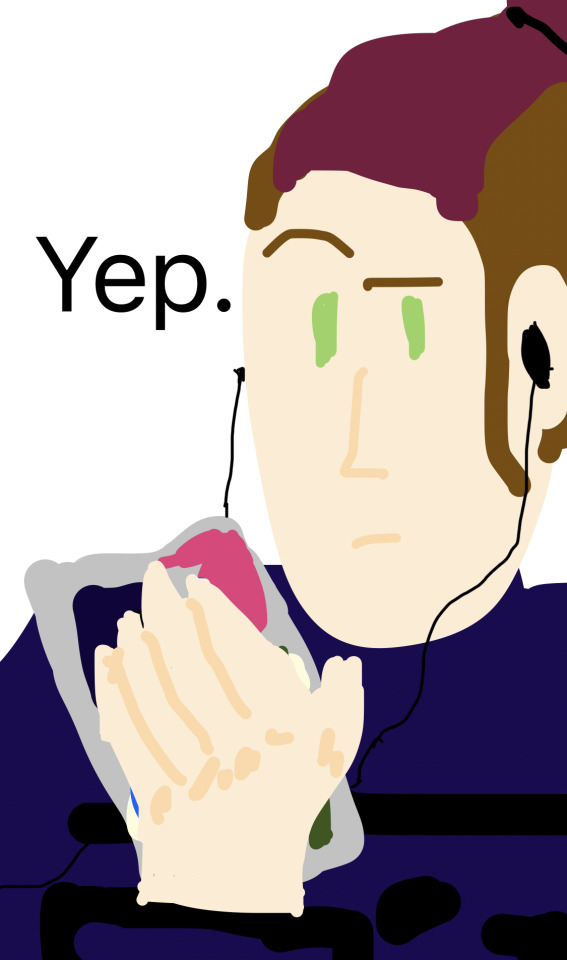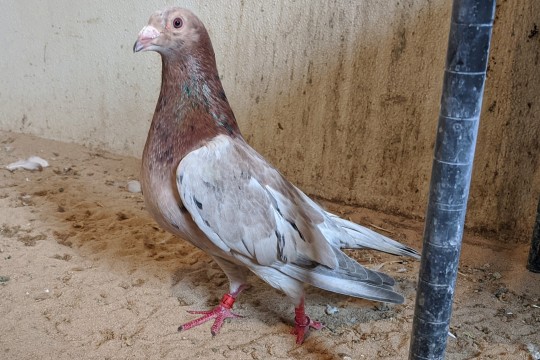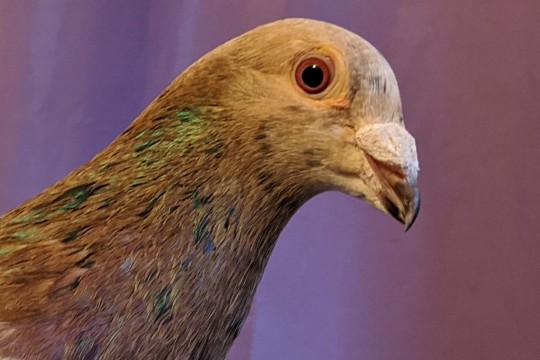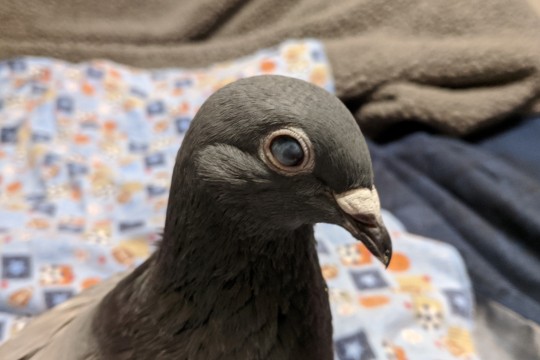#I add a single grain of sand to your enclosure
Note



Thanks for the year of good music!
(I realised right after drawing all this that your bio meant that you would be the one doing doodles, but I put too much work into this to get rid of it.)
things that have been read:
• the percy jackson fanfic I wrote when I was a literal child ❌
• me, to filth, by this ask ✅✅✅✅✅✅✅✅✅
#thank you so much though#for being kind to my little songs#I add a single grain of sand to your enclosure#your doodles are calorie rich and full of essential vitamins
5 notes
·
View notes
Note
You probably already get this question alot, but could I have some care tips (Cage requirements, food, basic care) and anything that might repel me from them? (Especially for a racing Homer - which is what I'm assuming they have here since pigeon racing is quite a big industry in my country) (I'd love to adopt but sadly that's not an option here since there's barely even dog rescues here) Thanks so much in advance!
I’ll start with what might repel you, starting with things inherent to the species, and then to potential effects of their personal history.
First thing’s first; DUST!!!
If you, or any one in your house hold, has dust related allergies or any respiratory issues at all, pigeons are not the pet for you.
They are dust monsters! For their size, the Columbidae produce more dust that any other domestic bird.
It is also a much finer dust. It floats in the air like thin smoke and takes a long time to settle, so you will breathe more of it with a group of pet pigeons than you would with parrots, chickens, quail, or song birds.
Definitely more than any mammalian dander that I know of.
Pigeons are only really territorial over what they consider a nest space.
Away from their nests, they are social and quite friendly, but the fiercely defend their nest from all comers.
If they are in a loft, or have free flight of a room, that aggression is constrained to the actual nest itself and anything with in about half a body length from the lip of it.
But if they are in a cage, the entire cage is space that they feel a powerful instinctive drive to defend.
Any uninvited entry is seen as an intrusion either by a predator or a rival, so I usually advise people not to attempt to physically interact at all with the pigeon in their cage.
Talking to the birds is fine, but all physical intrusion is seen as aggression that they have to defend against.
So, when you want to begin physically interacting with them, it’s best to invite them out into your room in the evening.
I’ll go into coop and home interaction training after the basic housing part.
Unless they are out of a sex linked pair, or you get them as fully mature adults, pigeons are absolute hell to sex.
Homers do become dimorphic as they age.

Karen is an adult racing homer cock.

Bird-bird is an adult hen of the same breed.

Look at Karen’s wattle (The thick skin above his nasal slits, at the base of his beak)

Now look at Bird-Bird’s.
His wattle is much bigger and more intricately developed than hers.
Her face is much finer featured than his.
He stands more upright.
She stands more horizontal.
But as peeps, they are nearly impossible to differentiate.
This is important, because the social behavior of cocks and hens and how it translates to humans tends to be VERY different.
Hens are VERY cuddly! Even into adulthood.
But adult cocks are platonically touch repulsed.
A flock mate is likely to make physical contact with a cock for one of two reasons: Another cock starting a fight, or a hen asking for sex.
They even make friends with flock mates through combat.
Until it sinks in otherwise, all attempts at physical contact with a cock is perceived as a challenge to a fight.
Non-aggressive contact with a cock is seen as an invitation for him to be your mate, and cock love is VERY pinchy!
Pigeon courtship consists of a three part ritual called Driving.
In the Chase trial, A cock will harass and bite a hen until she flees. If she was interested first, she’ll flirt to get his attention, and then fly off.
He HAS to chase her, keep up with her, and out maneuver her, all while herding her towards his nest so that she dives in when she’s too exhausted to continue to fly.
If he cannot out maneuver her, fly faster, and stay in the air longer than her, then her peeps will be more likely than her to be caught and eaten by a predator, and she will refuse that cock the opportunity to fill her eggs.
After she inspects the nest and has rested, she will try to leave. The second courtship trial revolves around blocking her exit and physically wrestling her back in until she is too exhausted to keep fighting him.
If he cannot block the generally smaller, weaker hen from leaving and fight her to a stand still, then he can’t hope to block another cock trying to force his way in, throw him out if he manages to pop in by surprise, or keep fighting him until he gives up.
Only after proving his stamina and strength to the Hen directly may he offer her a sample of the contents of his crop.
This is the sweet kissing part of courtship, after which they preen and cuddle and he’s allowed to step up onto her back and tread her.
This translates very poorly with a human partner, and if you have a cock as a companion, you have to be ok with a LOT of love bites before you can get to the soft cuddly part of the relationship.
Suddenly running up to you and biting out of nowhere is NOT aggression. They give LOTS of warning when they are upset.
Running up to attack you out of nowhere is a misguided attempt to begin Driving you, and he will go WAY over the top with it, because he is trying to impress a COLOSSUS with his physical strength, stamina, and tenacity.
You can understand how this could translate poorly to a human partner!
There are ways to respond to minimize the bitey bit, but we’ll get to those in another ask. This one is going to be VERY long as is.
Now, what we have just discussed is base line pigeon, with no outside components making anything more difficult.
Racers old enough to fly have been through daily training tosses; where they are grabbed, put in a basket, and released every day at increasing distances from the loft.
The best case scenario is a strong fear of hands from being grabbed and stuffed into the basket and occasionally restrained and injected with a vaccine.
The luckiest individuals have only had to navigate for miles every day to return to safety, food, and family.
Racing birds can also have to dodge hawks, or fly through inclement weather during training flights.
Some can even make it home severely injured.
Understandably, adult racers of either sex will need to be patiently worked through a STRONGLY reinforced fear of hands.
We have lots of posts discussing how to work with fearful pigeons, and I’ll be happy to go into it again in more detail, but that’s another for a different post.
Basics of care for pigeons are very simple.
They are strict granivores. Seeds are all they can digest, but they can eat a very wide variety of seeds. The more variation, the better.
Pigeons do not hull their seeds. They swallow them whole, and depend on the hulls as vital dietary fiber, so don’t give them seed that is already hulled.
Their diet should involve as much variety of seed, grains, and legumes as you can get your hands on, the size of an unpopped kernel of popcorn or smaller (Most breeds can;t swallow seeds much bigger than that) with some source of calcium available.
You can have a separate dish of oyster shell, or you can sprinkle powder in a single birds daily meal, or add liquid calcium to their water dish.
NOT all of those at once! Calcium can be overdosed!
Which ever method works most easily for you and your bird.
Pigeons are intensely social birds that get most of their enrichment from interaction.
They are happiest as free roaming house pets, like a cat or dog, that can come see you or go do their own thing as they choose.
Pigeons are smart enough to learn house rules.
Understandably, that is not an option for every one, and free roaming unsupervised before they learn the house rules can be dangerous.

If you cannot let the bird free roam their own room, you can easily modify a dog crate to house them comfortably.
They need square perches. Because they are cliff nesters, round perches put painful pressure on the ball of their feet, making walking painful.
I like to cut garden stakes to length and wire them into place.
A corner bunny litter pan is a decent nest box, but not necessary. They will nest just as happily in a cheap dog food dish.
Pigeons are ground foragers, so they prefer a shallow dish of food on the floor of their enclosure.
Ideally, the modified crate cage for the pigeon should be used like it would be for a pet dog; That is not where the animal lives full time.
That is where it sleeps at night or hangs out when you aren’t home to supervise it, until it learns the house rules.
Toys are very simple, because their interaction tools are very limited.
Pigeons can recognize themselves in mirrors and love to play with them.
They enjoy bathing in a dish of water about hip-deep.
They can have sand or straw filled forage boxes to hunt for treats like safflower seeds in.
Stick-shaped, Shiny, and Jingly is their holy trinity of toy characteristics.
q-tips with the cotton tips cut off, tooth picks with the points clipped, wicker kitty balls with jingle bells inside, bread ties with jingle bells that are too big to accidentally swallow twisted to either side, or made into a jingly ring, are all cheap, simple toys that a single pet bird will have fun playing with.
I mentioned coop training earlier, and it’s super simple.
Starting in the evening, open the door to the cage and invite the bird out.
Don’t hang around waiting for it to come. Go settle in to do something quiet and sedentary, like reading a book or surfing the net.
Pigeons are naturally curious, and the best way to work then through the fear of people they may have developed is to be as nonthreatening as possible and reward their curiosity.
Talk to them to desensitize them to your voice and start teaching them how you communicate.
They will eventually grow brave enough to come explore you yourself.
A quiet, pleased greeting will reward them by not startling them.
Have safflower seeds available, but don’t try to reach out to give it to the birds.
Let them discover that you have them, and be still and non-reactive when they take some. Offer verbal praise, but don’t start trying to move until they ease away from automatic flightiness.
I specify beginning this process in the evening because trying to get a bird back into the crate before it trusts you is very difficult and your best bet to avoid making it afraid of you despite your friend-making efforts is to avoid having to chase it back into its pen at the end of flight time.
Starting these in the evening allows you the option to avoid chasing entirely just by turning off the lights.
At the end of out time, give a verbal warning like “Lights out” or “Bed Time”, and then wait a minute or two before actually turning off the light.
Pick the bird up in the dark, and return it gently to its enclosure.
It will begin to associate the “Lights out” or “Bed time” warning with the lights going out, and eventually learn to fly back to the pen in the space of time before the lights actually go out.
That’s about the skin and bone basics of care.
Please, by all means, send more asks for more information on any aspect or detail of pet pigeon keeping.
I am always happy to answer. ^v^
176 notes
·
View notes